热门标签
热门文章
- 1okhttp的使用以及 post json进行请求数据_okhttputil.postjson
- 2【git-http】Windows中git输错密码后不能重新输入的问题_git凭据删除
- 3postman 接口测试入门到精通_精通postman接口测试博客
- 4Hadoop搭建之 start-yarn.sh 报错_start-yarn.sh报错
- 5SQL Server 的命名规则_sql server 数据库名称命名规则
- 6【小沐学Python】Python实现WebUI网页图表(gradio)_python webui demo
- 7CTFshow-Web入门-信息泄露_\u4f60\u8d62\u4e86\uff0c\u53bb\u5e7a\u5e7a\u96f6\u
- 8BugKu-Web_您需要传入一个名为flag的参数。
- 9Description Resource Path Location TypeCannot change version of project facet Dynamic Web Module to_descriptionresourcepathlocationtype cannot change
- 10Python 自动化操作 Excel 看这一篇就够了,办公效率直线提升︕_python excel
当前位置: article > 正文
Python 使用 NetworkX_python networkx
作者:很楠不爱3 | 2024-04-25 23:12:20
赞
踩
python networkx
Python 使用 NetworkX
说明:本篇文章主要讲述 python 使用 networkx 绘制有向图;
1. 介绍&安装
NetworkX 是一个用于创建、操作和研究复杂网络的 Python 库。它提供了丰富的功能,可以帮助你创建、分析和可视化各种类型的网络,例如社交网络、Web图、生物网络等。NetworkX 可以用来创建各种类型的网络,包括有向图和无向图。它提供了各种方法来添加、删除和修改网络中的节点和边。你可以使用节点和边的属性来进一步描述网络的特性。
NetworkX 还提供了许多图的算法和分析工具。你可以使用这些工具来计算各种网络指标,比如节点的度、网络的直径、最短路径等。你还可以使用它来发现社区结构、进行图的聚类分析等。
除了功能强大的操作和分析工具,NetworkX还提供了多种方式来可视化网络。你可以使用它来绘制网络的节点和边,设置节点的颜色、尺寸和标签等。
总的来说,NetworkX是一个功能丰富、灵活易用的Python库,用于创建、操作和研究各种类型的复杂网络。无论你是在进行学术研究、数据分析还是网络可视化,NetworkX都是一个不错的选择。
安装
pip install networkx
- 1
2. 简单的有向图绘制
简单的类展示
import networkx as nx # 导入 NetworkX 工具包
# 创建 图
G1 = nx.Graph() # 创建:空的 无向图
G2 = nx.DiGraph() #创建:空的 有向图
G3 = nx.MultiGraph() #创建:空的 多图
G4 = nx.MultiDiGraph() #创建:空的 有向多图
- 1
- 2
- 3
- 4
- 5
- 6
三节点有向图的绘制
# -*- coding: utf-8 -*- import networkx as nx import matplotlib.pyplot as plt # 1. 创建有向图对象, 创建空的有向图的对象 G = nx.DiGraph() # 2. 添加节点 G.add_node('A') G.add_node('B') G.add_node('C') # 3. 添加有向边 G.add_edge('A', 'B') G.add_edge('B', 'C') # 4. 进行图的绘制 pos = nx.spring_layout(G) # 选择布局算法; nx.draw(G, pos, with_labels=True) plt.show()
- 1
- 2
- 3
- 4
- 5
- 6
- 7
- 8
- 9
- 10
- 11
- 12
- 13
- 14
- 15
- 16
- 17
- 18
- 19
- 20
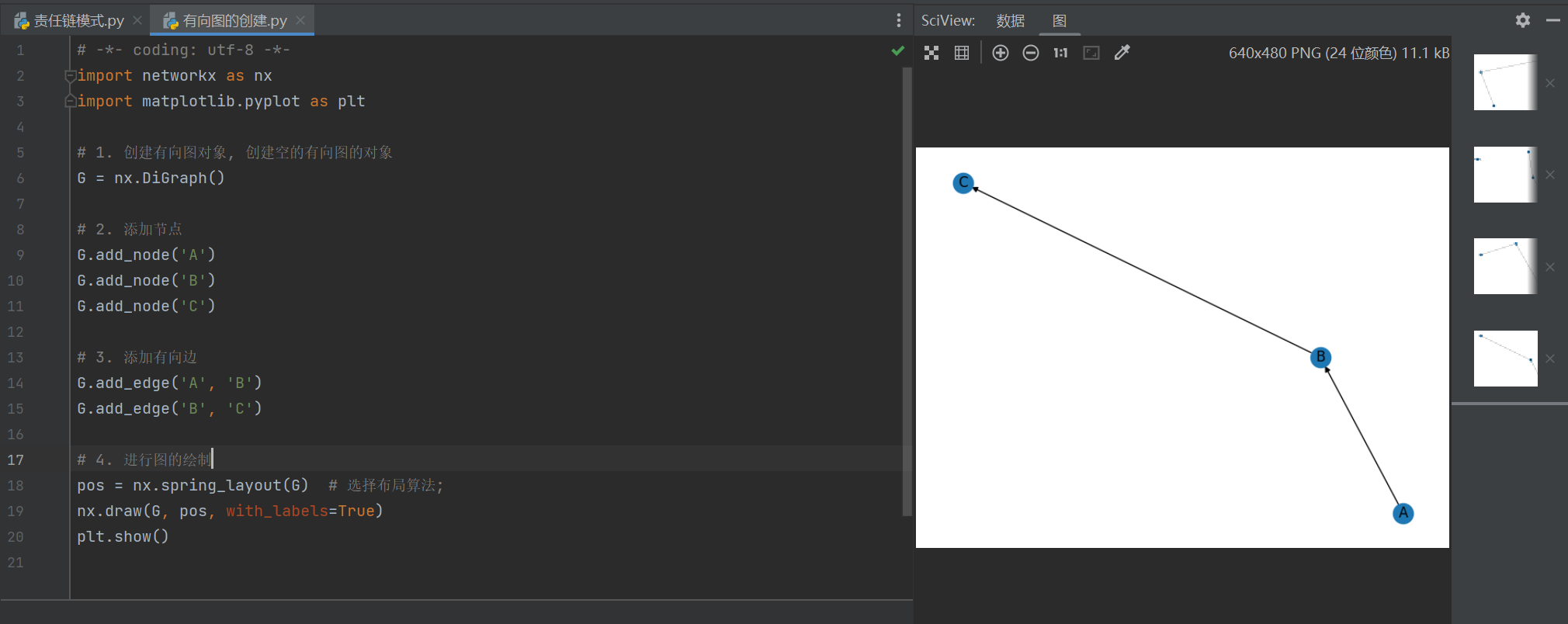
绘制分支节点的有向图
# -*- coding: utf-8 -*- import networkx as nx import matplotlib.pyplot as plt # 1. 创建有向图对象, 创建空的有向图的对象 G = nx.DiGraph() # 2. 添加节点 G.add_node('A') G.add_node('B') G.add_node('C') G.add_node('D') G.add_node('E') # 3. 添加有向边 G.add_edge('A', 'B') G.add_edge('B', 'C') G.add_edge('B', 'D') G.add_edge('C', 'E') # 4. 进行图的绘制 pos = nx.spring_layout(G) # 选择布局算法; nx.draw(G, pos, with_labels=True) plt.show()
- 1
- 2
- 3
- 4
- 5
- 6
- 7
- 8
- 9
- 10
- 11
- 12
- 13
- 14
- 15
- 16
- 17
- 18
- 19
- 20
- 21
- 22
- 23
- 24
- 25
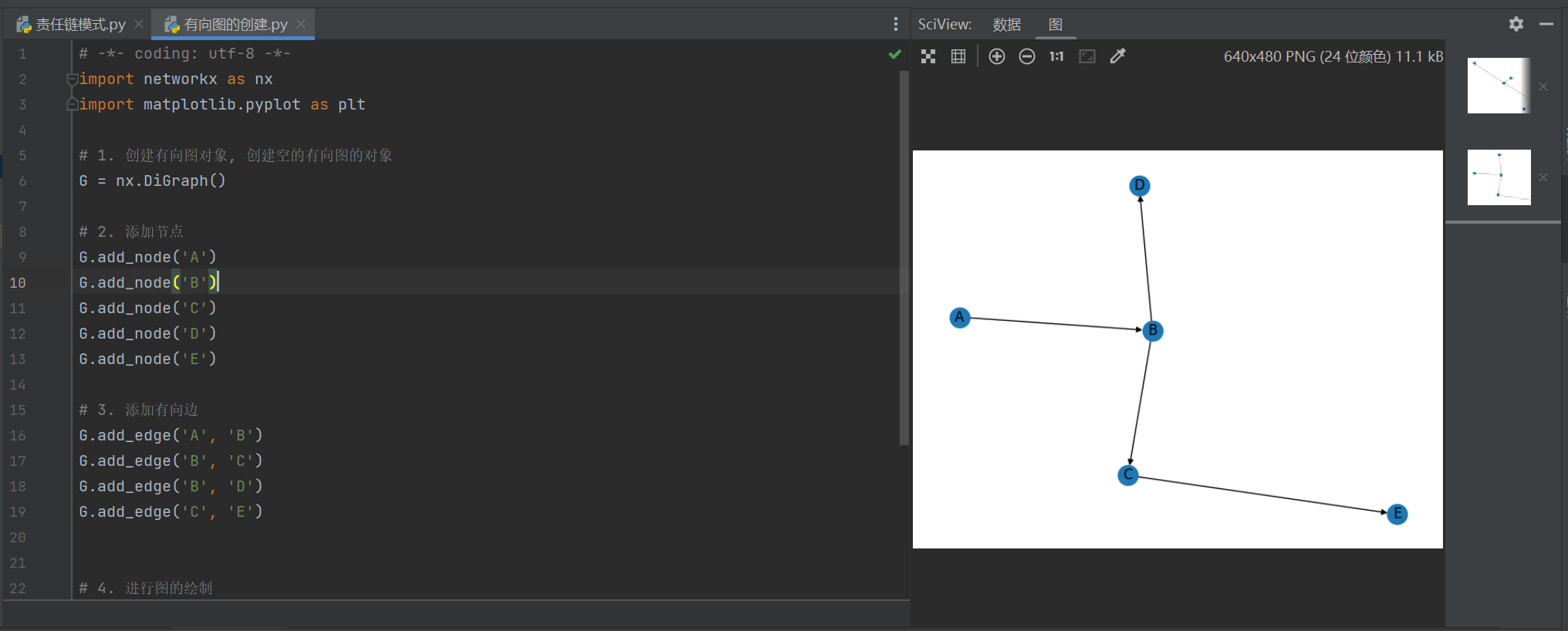
3.有向图的遍历
三节点有向图的遍历
# -*- coding: utf-8 -*- import networkx as nx import matplotlib.pyplot as plt # 1. 创建有向图对象, 创建空的有向图的对象 G = nx.DiGraph() # 2. 添加节点 G.add_node('A') G.add_node('B') G.add_node('C') # G.add_node('D') # G.add_node('E') # 3. 添加有向边 G.add_edge('A', 'B') G.add_edge('B', 'C') # G.add_edge('B', 'D') # G.add_edge('C', 'E') # 4. 进行图的绘制 pos = nx.spring_layout(G) # 选择布局算法; nx.draw(G, pos, with_labels=True) plt.show() # 5. 有向图的遍历 print(G.nodes) # 节点列表, 输出节点 列表 for node in G.nodes(): print("节点>>>", node)
- 1
- 2
- 3
- 4
- 5
- 6
- 7
- 8
- 9
- 10
- 11
- 12
- 13
- 14
- 15
- 16
- 17
- 18
- 19
- 20
- 21
- 22
- 23
- 24
- 25
- 26
- 27
- 28
- 29
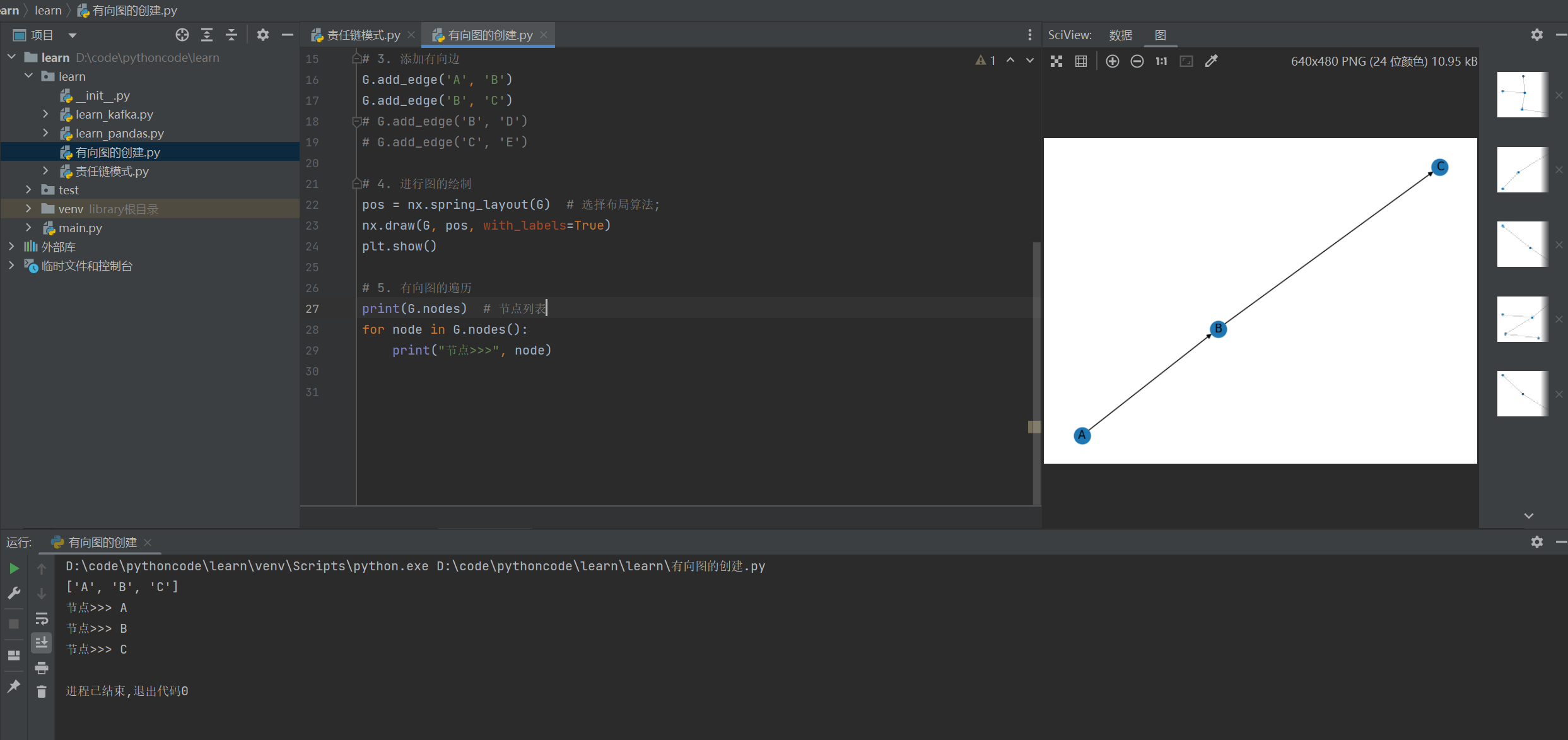
绘制分支节点图形的输出
# -*- coding: utf-8 -*- import networkx as nx import matplotlib.pyplot as plt # 1. 创建有向图对象, 创建空的有向图的对象 G = nx.DiGraph() # 2. 添加节点 G.add_node('A') G.add_node('B') G.add_node('C') G.add_node('D') G.add_node('E') # 3. 添加有向边 G.add_edge('A', 'B') G.add_edge('B', 'C') G.add_edge('B', 'D') G.add_edge('C', 'E') # 4. 进行图的绘制 pos = nx.spring_layout(G) # 选择布局算法; nx.draw(G, pos, with_labels=True) plt.show() # 5. 有向图的遍历 print(G.nodes) # 节点列表 # print(G.edges) # 边列表, [('A', 'B'), ('B', 'C'), ('B', 'D'), ('C', 'E')] for node in G.nodes(): print("节点>>>", node) in_degree = G.in_degree(node) print("入度:", in_degree) # 获取节点的出度 out_degree = G.out_degree(node) print("出度:", out_degree) # 获取节点的邻居节点 neighbors = G.neighbors(node) print("邻居节点:", list(neighbors))
- 1
- 2
- 3
- 4
- 5
- 6
- 7
- 8
- 9
- 10
- 11
- 12
- 13
- 14
- 15
- 16
- 17
- 18
- 19
- 20
- 21
- 22
- 23
- 24
- 25
- 26
- 27
- 28
- 29
- 30
- 31
- 32
- 33
- 34
- 35
- 36
- 37
- 38

4.带权重的边
本章节的内容主要展示带权重的边的绘制,并且求取出最大值和最小值;
# -*- coding: utf-8 -*- import networkx as nx import matplotlib.pyplot as plt # 创建有向图 G = nx.DiGraph() # 直接创建边, 自动添加两个节点, 并且设置边的权重 G.add_edge('A', 'B', weight=3) G.add_edge('B', 'C', weight=5) G.add_edge('C', 'D', weight=2) G.add_edge('C', 'E', weight=5) pos = nx.spring_layout(G) nx.draw(G, pos, with_labels=True) # 获取边的权重 labels = nx.get_edge_attributes(G, 'weight') # 绘制带有权重的边 nx.draw_networkx_edge_labels(G, pos, edge_labels=labels) plt.show() # 获取边的权重值列表 weights = nx.get_edge_attributes(G, 'weight').values() print("边的权重值列表>>>", weights) max_weight = max(weights) min_weight = min(weights) print("最大权重的边:", max_weight) print("最小权重的边:", min_weight)
- 1
- 2
- 3
- 4
- 5
- 6
- 7
- 8
- 9
- 10
- 11
- 12
- 13
- 14
- 15
- 16
- 17
- 18
- 19
- 20
- 21
- 22
- 23
- 24
- 25
- 26
- 27
- 28
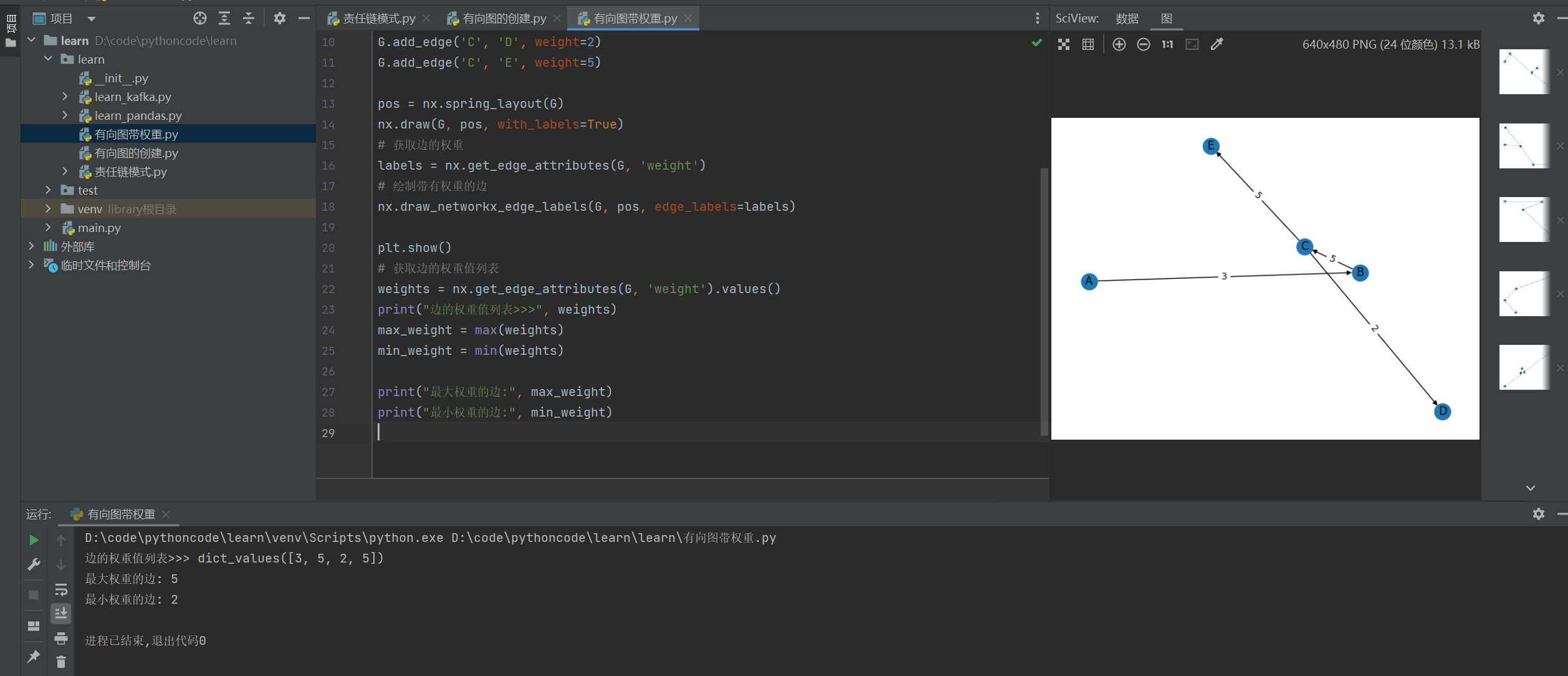
求取图形中得最短路径
# -*- coding: utf-8 -*- import networkx as nx import matplotlib.pyplot as plt def get_shortest_path(graph, source, target): try: shortest_path = nx.shortest_path(graph, source, target) return shortest_path except nx.exception.NetworkXNoPath: return "不存在最短路径" def get_longest_path(graph, source, target): all_paths = nx.all_simple_paths(graph, source, target) longest_path = max(all_paths, key=len) return longest_path # 创建有向图 G = nx.DiGraph() G.add_edge('A', 'B') G.add_edge('A', 'C') G.add_edge('B', 'C') G.add_edge('B', 'D') G.add_edge('C', 'D') pos = nx.spring_layout(G) # 选择布局算法; nx.draw(G, pos, with_labels=True) plt.show() # 求取最短路径 shortest_path = get_shortest_path(G, 'A', 'D') print("最短路径:", shortest_path) # 求取最长路径 longest_path = get_longest_path(G, 'A', 'D') print("最长路径:", longest_path)
- 1
- 2
- 3
- 4
- 5
- 6
- 7
- 8
- 9
- 10
- 11
- 12
- 13
- 14
- 15
- 16
- 17
- 18
- 19
- 20
- 21
- 22
- 23
- 24
- 25
- 26
- 27
- 28
- 29
- 30
- 31
- 32
- 33
- 34
- 35
- 36
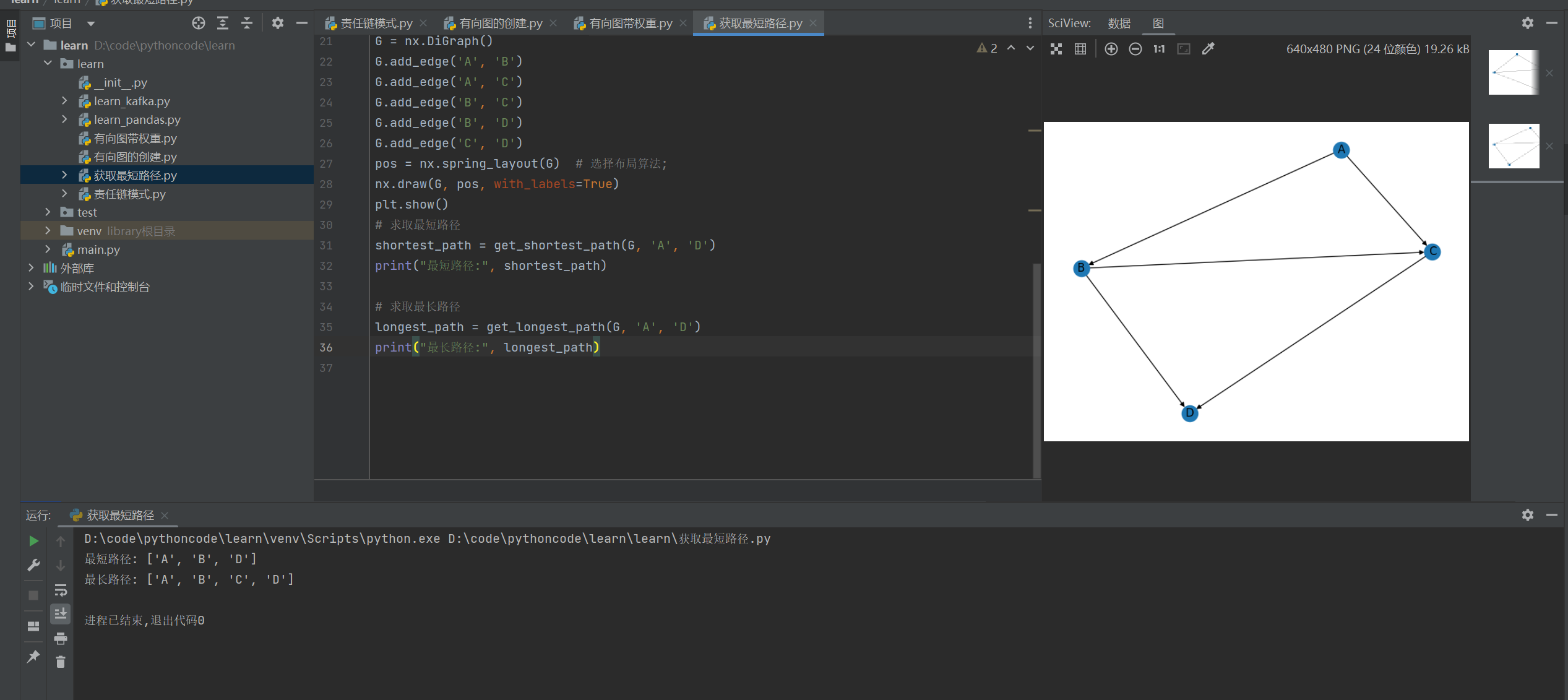
按照权重求最短路径&最长路径
# -*- coding: utf-8 -*- import networkx as nx import matplotlib.pyplot as plt # 创建有向带权重图 G = nx.DiGraph() G.add_edge('A', 'B', weight=3) G.add_edge('A', 'C', weight=5) G.add_edge('B', 'C', weight=2) G.add_edge('B', 'D', weight=4) G.add_edge('C', 'D', weight=1) pos = nx.spring_layout(G) nx.draw(G, pos, with_labels=True) # 获取边的权重 labels = nx.get_edge_attributes(G, 'weight') # 绘制带有权重的边 nx.draw_networkx_edge_labels(G, pos, edge_labels=labels) plt.show() # 按照权重求取最短路径 shortest_path = nx.dijkstra_path(G, 'A', 'D', weight='weight') shortest_distance = nx.dijkstra_path_length(G, 'A', 'D', weight='weight') print("最短路径:", shortest_path) print("最短距离:", shortest_distance)
- 1
- 2
- 3
- 4
- 5
- 6
- 7
- 8
- 9
- 10
- 11
- 12
- 13
- 14
- 15
- 16
- 17
- 18
- 19
- 20
- 21
- 22
- 23
- 24
- 25
- 26
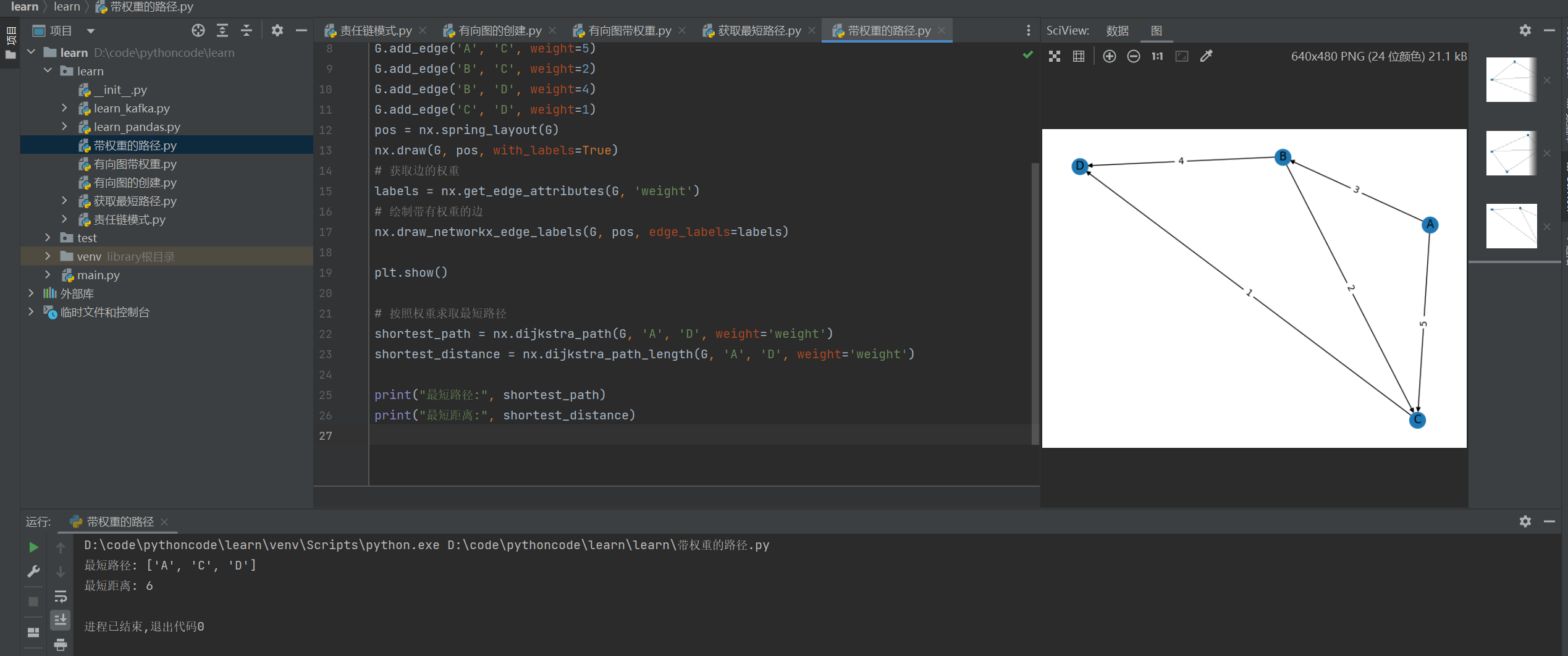
import networkx as nx # 创建有向带权重图 G = nx.DiGraph() G.add_edge('A', 'B', weight=3) G.add_edge('A', 'C', weight=5) G.add_edge('B', 'C', weight=2) G.add_edge('B', 'D', weight=4) G.add_edge('C', 'D', weight=1) # 将边的权重取相反数 G_neg = nx.DiGraph() for u, v, data in G.edges(data=True): G_neg.add_edge(u, v, weight=-data['weight']) # 按照权重取相反数的图中求取最短路径 longest_path = nx.dijkstra_path(G_neg, 'A', 'D', weight='weight') longest_distance = -nx.dijkstra_path_length(G_neg, 'A', 'D', weight='weight') print("最长路径:", longest_path) print("最长距离:", longest_distance)
- 1
- 2
- 3
- 4
- 5
- 6
- 7
- 8
- 9
- 10
- 11
- 12
- 13
- 14
- 15
- 16
- 17
- 18
- 19
- 20
- 21
5.json 数据的转换
**说明:**前后端交互的时候通常传回的时候的 json 格式化后的数据,通常需要构建一下,因此最好创建一个统一的类进行封装。
# -*- coding: utf-8 -*- """图的封装; """ import networkx as nx import matplotlib.pyplot as plt class GraphDict(object): """有向图的构造; """ def __init__(self): """初始化的封装; """ self.graph = None # 有向图的构建 self.graph_weight = None # 有向图带权重 def dict_to_graph(self, data: list): """ 图的字典模式; :param data: :return: example: data=[{ source: 'Node 1', target: 'Node 3' }, { source: 'Node 2', target: 'Node 3' }, { source: 'Node 2', target: 'Node 4' }, { source: 'Node 1', target: 'Node 4' }] """ graph = nx.DiGraph() # 创建有向图 # 循环添加边, 直接添加上节点 for item in data: graph.add_edge(item.get('source'), item.get("target")) # 赋值并返回 self.graph = graph return graph def dict_to_graph_weight(self, data: list): """ 图的字典模式, 带权重; :param data: :return: example: data = [ { source: 'Node 1', target: 'Node 3', weight: 5 }, { source: 'Node 2', target: 'Node 3', weight: 3, }, { source: 'Node 2', target: 'Node 4', weight: 5, }, { source: 'Node 1', target: 'Node 4', weight: 5 } ] """ graph = nx.DiGraph() # 创建有向图 # 循环添加边, 直接添加上节点, 并且为边赋值上权重; for item in data: graph.add_edge(item.get('source'), item.get("target"), weight=item.get("weight")) # 赋值并返回 self.graph_weight = graph return graph def graph_to_dict(self): """ 图的数据转换成为字典的数据; :return: """ assert self.graph is not None or self.graph_weight is not None, "必须首先通过该类创建一个有向图" if self.graph is None: edges = self.graph_weight.edges(data=True) return [{"source": s, "target": t, "weight": w['weight']} for s, t, w in edges] else: edges = self.graph.edges() return [{"source": s, "target": t} for s, t in edges] def show(self): """ 有向图的显示; :return: """ assert self.graph is not None or self.graph_weight is not None, "必须首先通过该类创建一个有向图" if self.graph is None: pos = nx.spring_layout(self.graph_weight) nx.draw(self.graph_weight, pos, with_labels=True) labels = nx.get_edge_attributes(self.graph_weight, 'weight') nx.draw_networkx_edge_labels(self.graph_weight, pos, edge_labels=labels) plt.show() else: pos = nx.spring_layout(self.graph) nx.draw(self.graph, pos, with_labels=True) plt.show() def to_png(self, name: str): """ 导出有向图的 png 图片; :param name; str, 想要导出 png 图片的名称; :return: """ assert self.graph is not None or self.graph_weight is not None, "必须首先通过该类创建一个有向图" if self.graph is None: pos = nx.spring_layout(self.graph_weight) nx.draw(self.graph_weight, pos, with_labels=True) labels = nx.get_edge_attributes(self.graph_weight, 'weight') nx.draw_networkx_edge_labels(self.graph_weight, pos, edge_labels=labels) plt.savefig(name) else: pos = nx.spring_layout(self.graph) nx.draw(self.graph, pos, with_labels=True) plt.savefig(name) if __name__ == '__main__': graph = GraphDict() data = [ { "source": 'Node 1', "target": 'Node 3' }, { "source": 'Node 2', "target": 'Node 3' }, { "source": 'Node 2', "target": 'Node 4' }, { "source": 'Node 1', "target": 'Node 4' }] data_weight = [ { "source": 'Node 1', "target": 'Node 3', "weight": 3 }, { "source": 'Node 2', "target": 'Node 3', "weight": 3 }, { "source": 'Node 2', "target": 'Node 4', "weight": 3 }, { "source": 'Node 1', "target": 'Node 4', "weight": 3 }] # graph.dict_to_graph(data) # graph.to_png("有向图的导出") graph.dict_to_graph_weight(data_weight) graph.to_png("权重") v = graph.graph_to_dict() print(v)
- 1
- 2
- 3
- 4
- 5
- 6
- 7
- 8
- 9
- 10
- 11
- 12
- 13
- 14
- 15
- 16
- 17
- 18
- 19
- 20
- 21
- 22
- 23
- 24
- 25
- 26
- 27
- 28
- 29
- 30
- 31
- 32
- 33
- 34
- 35
- 36
- 37
- 38
- 39
- 40
- 41
- 42
- 43
- 44
- 45
- 46
- 47
- 48
- 49
- 50
- 51
- 52
- 53
- 54
- 55
- 56
- 57
- 58
- 59
- 60
- 61
- 62
- 63
- 64
- 65
- 66
- 67
- 68
- 69
- 70
- 71
- 72
- 73
- 74
- 75
- 76
- 77
- 78
- 79
- 80
- 81
- 82
- 83
- 84
- 85
- 86
- 87
- 88
- 89
- 90
- 91
- 92
- 93
- 94
- 95
- 96
- 97
- 98
- 99
- 100
- 101
- 102
- 103
- 104
- 105
- 106
- 107
- 108
- 109
- 110
- 111
- 112
- 113
- 114
- 115
- 116
- 117
- 118
- 119
- 120
- 121
- 122
- 123
- 124
- 125
- 126
- 127
- 128
- 129
- 130
- 131
- 132
- 133
- 134
- 135
- 136
- 137
- 138
- 139
- 140
- 141
- 142
- 143
- 144
- 145
- 146
- 147
- 148
- 149
- 150
- 151
- 152
- 153
- 154
- 155
- 156
- 157
- 158
- 159
- 160
- 161
- 162
- 163
- 164
- 165
- 166
- 167
- 168
- 169
- 170
- 171
- 172
- 173
- 174
- 175
- 176
- 177
- 178
- 179
- 180
- 181
- 182
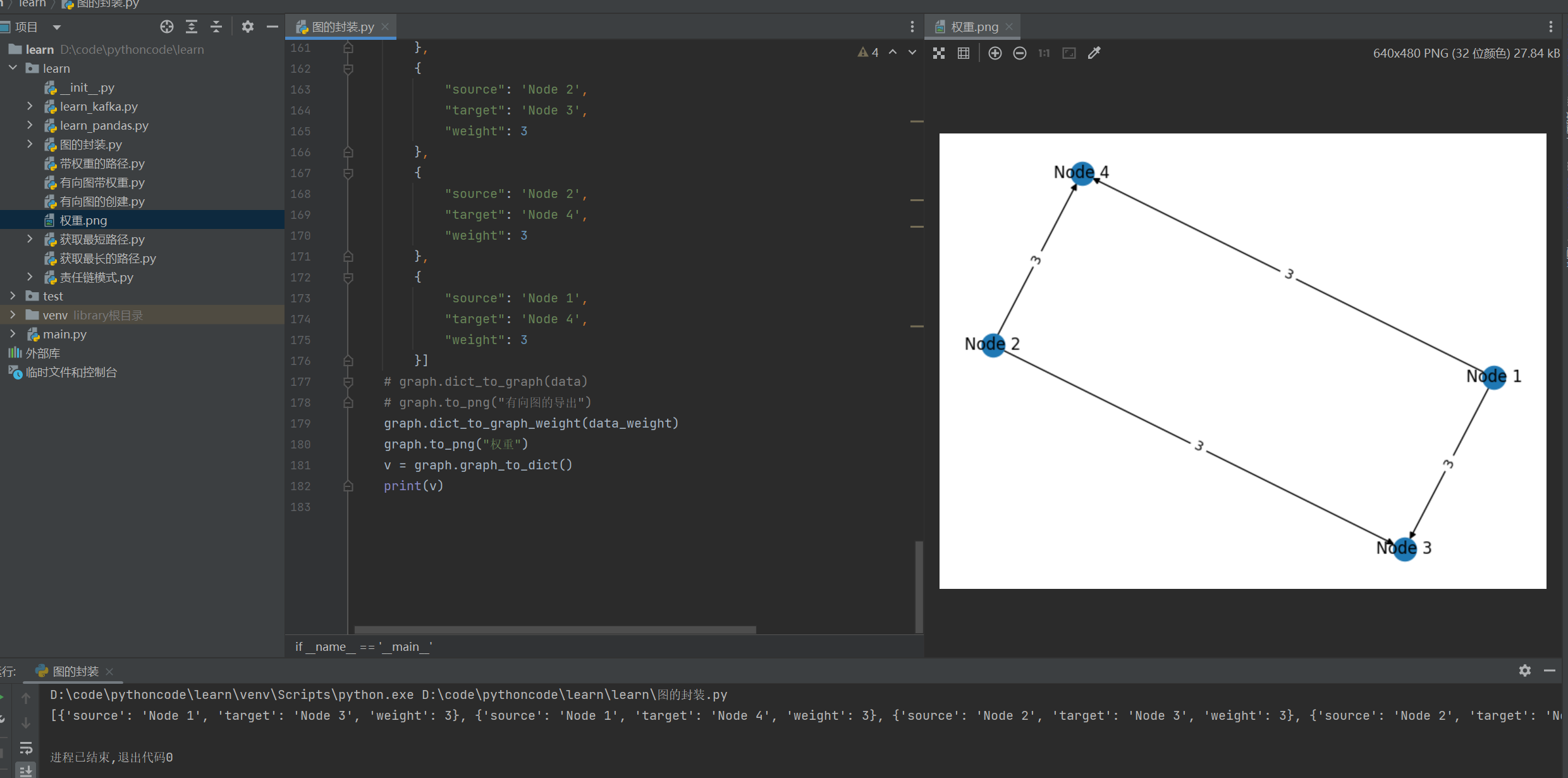
继续努力,终成大器;
声明:本文内容由网友自发贡献,不代表【wpsshop博客】立场,版权归原作者所有,本站不承担相应法律责任。如您发现有侵权的内容,请联系我们。转载请注明出处:https://www.wpsshop.cn/w/很楠不爱3/article/detail/487709
推荐阅读
相关标签






